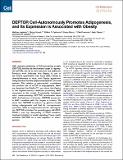DEPTOR Cell-Autonomously Promotes Adipogenesis, and Its Expression Is Associated with Obesity
Author(s)
Laplante, Mathieu; Horvat, Simon; Festuccia, William T.; Birsoy, Kivanc; Prevorsek, Zala; Efeyan, Alejo; Sabatini, David M.; Sabatini, David; ... Show more Show less
DownloadLaplante-2012-DEPTOR Cell-Autonomo.pdf (1.227Mb)
PUBLISHER_POLICY
Publisher Policy
Article is made available in accordance with the publisher's policy and may be subject to US copyright law. Please refer to the publisher's site for terms of use.
Terms of use
Metadata
Show full item recordAbstract
DEP domain-containing mTOR-interacting protein (DEPTOR) inhibits the mechanistic target of rapamycin (mTOR), but its in vivo functions are unknown. Previous work indicates that Deptor is part of the Fob3a quantitative trait locus (QTL) linked to obesity/leanness in mice, with Deptor expression being elevated in white adipose tissue (WAT) of obese animals. This relation is unexpected, considering the positive role of mTOR in adipogenesis. Here, we dissected the Fob3a QTL and show that Deptor is the highest-priority candidate promoting WAT expansion in this model. Consistently, transgenic mice overexpressing DEPTOR accumulate more WAT. Furthermore, in humans, DEPTOR expression in WAT correlates with the degree of obesity. We show that DEPTOR is induced by glucocorticoids during adipogenesis and that its overexpression promotes, while its suppression blocks, adipogenesis. DEPTOR activates the proadipogenic Akt/PKB-PPAR-γ axis by dampening mTORC1-mediated feedback inhibition of insulin signaling. These results establish DEPTOR as a new regulator of adipogenesis.
Date issued
2012-08Department
Massachusetts Institute of Technology. Department of Biology; Whitehead Institute for Biomedical Research; Koch Institute for Integrative Cancer Research at MITJournal
Cell Metabolism
Publisher
Elsevier
Citation
Laplante, Mathieu, Simon Horvat, William T. Festuccia, Kivanç Birsoy, Zala Prevorsek, Alejo Efeyan, and David M. Sabatini. “DEPTOR Cell-Autonomously Promotes Adipogenesis, and Its Expression Is Associated with Obesity.” Cell Metabolism 16, no. 2 (August 2012): 202–212. © 2012 Elsevier Inc.
Version: Final published version
ISSN
15504131